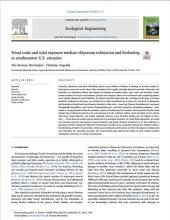
Abstract
Annually, shipworms and other biofouling species cause millions of dollars in damage to wooden marine infrastructure across the world. Given their abundant larval supply and high dispersal potential, bioeroders and biofoulers are ubiquitous threats that shorten the lifespan of wooden docks, piers, boats and shoreline stabilization structures in coastal environments. Despite these impacts, there are no treatments that completely protect wood against shipworms and biofouling. To explore potential approaches for extending the lifespan of wooden shoreline stabilization structures, we conducted two field experiments to evaluate the resistance to shipworms and biofouling of small and large diameter branches of four trees - laurel oak (Quercus hemisphaerica), sweetgum (Liquidambar styraciflua), crepe myrtle (Lagerstroemia spp.), and black mangrove (Avicennia germinans) - positioned at varying distances from the sediment surface in southeastern US estuaries. We discovered that the wood volume lost to shipworm burrows was concentrated near the sediment surface, more prevalent in tree species with lower wood densities, and varied markedly between years. Barnacle fouling was far higher on branches > 30 cm from the surface and on laurel oak and sweetgum branches. In a third field experiment, we tested two chemical and two non-chemical wood treatments and found chemical treatments to be more effective at deterring barnacle fouling and shipworm burrowing of wooden posts, especially beneath the sediment surface. By identifying desirable characteristics of the wood employed and elevations at which the impacts of shipworms and biofouling are especially prevalent, this experimental study informs the design of more durable wooden stabilization structures in coastal environments.
About this article
This journal article was developed by a graduate student working closely with a collaborative research team studying new designs for living shorelines.
Bersoza Hernández, A., Angelini, C., 2019. Wood traits and tidal exposure mediate shipworm infestation and biofouling in southeastern U.S. estuaries. Ecological Engineering 132, 1-12. https://doi.org/10.1016/j.ecoleng.2019.03.008